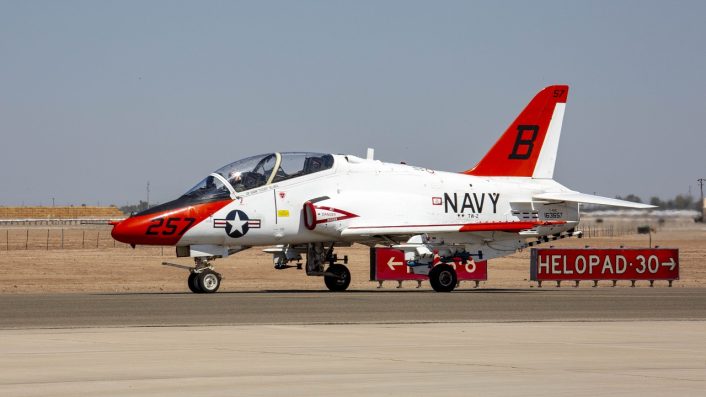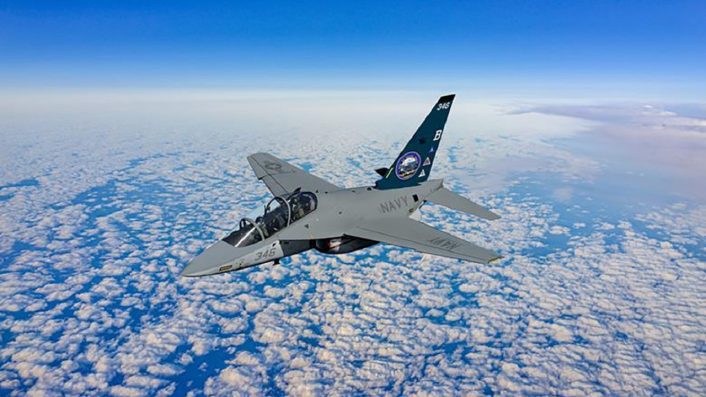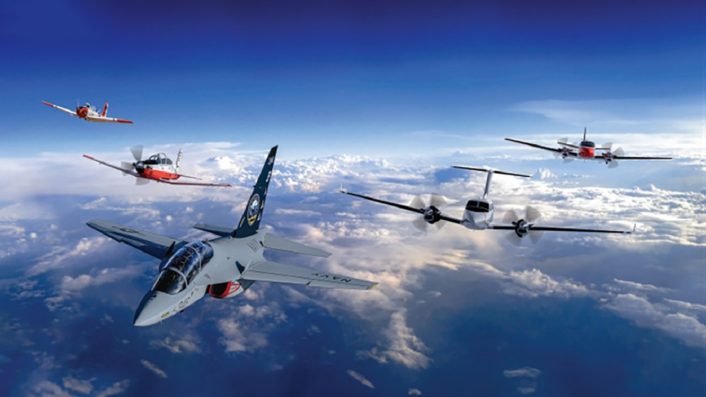The next generation Undergraduate Jet Training System will replace the aging T-45 Goshawk, with the candidates being the Leonardo-Textron M-346N, the Boeing-Saab T-7 and the Lockheed Martin-KAI T-50.
The U.S. Navy released yet again another Request For Information (RFI) for the program which will replace the aging T-45 Goshawk, the Undergraduate Jet Training System (UJTS). This is the program’s fourth RFI, although the final Request for Proposals (RFP) was also expected later this year.
The first difference that comes to the eye in this latest RFI is the anticipated contract award date, which has now been pushed from Fiscal Year 2026 to Q2FY2028. Also, there is one of the main requirements still uncertain, as carefully noted in the RFI description.
“Please note that the Naval Aviation Enterprise (NAE) Senior Leadership is still carefully considering whether the UJTS air vehicle will need to conduct Field Carrier Landing Practice (FCLP) to touchdown,” says the document. As we reported, a good portion of the training command’s syllabus is centered around the FCLP, which allows new pilots to train on land bases for the entire approach and landing maneuver as performed on the aircraft carrier, just short of the arrested landing.
The latest RFI
The RFI includes a list of desired attributes for the Navy’s new jet training aircraft, many of which were already known from the previous RFIs. We will briefly examine these attributes, beginning from the cockpit.
The attribute requested for the cockpit feature the safety and environmental characteristics common to all modern aircraft, including zero-zero ejection seats and bird strike-resistant canopy. The latter is quite obvious as the Navy lost some aircraft because of the bird strike problem and obviously wants to minimize the chances of this happening again.
As for the cockpit configuration, the service is requesting an aircraft with Head-Up Display (HUD) and a “single, primary touch-screen display in both cockpits”, as well as Helmet Mounted Displays (HMD) with integrated Augmented Reality (AR) and capable of being used simultaneously or individually in the FWD and AFT cockpit. The Large Area Display (LAD) requirement was expected as the Navy already employs LADs on the F-35C and F/A-18 Block III aircraft that would be flown by pilots graduated on the UJTS.
The RFI then moves to suitability and performance attributes, beginning from the capability to maintain fixed Angle of Attack (AoA) approach targeting 3.25 degree glideslope while maintaining field of view during unflared landings. The aircraft is expected to perform 6-10 unflared landings per training event, or 1,400 landings per year assuming 400 flight hours per year, and a total of 10,000 hours of airframe fatigue life and 35,000 landings.
Because of this, the structural design needs to account for very significant stresses during the landing, possibly needing structural modifications. However, as mentioned in the beginning of the RFI, we will have to wait for the final RFP to see what the final decision on that will be and define exactly the requirements for the aircraft.

As for the performance, the Navy is looking for an aircraft capable of a speed of at least Mach 0.9/450-500 KIAS, sustained AoA over 20 deg, sustained load factor of at least 6 G, operating ceiling of at least 41,000 ft and turn rate of at least 12 deg/sec. The RFI also mentions wing and/or wingtip pylons for stores carriage, which in the attachment are better specified as external fuel tanks, luggage pod and PMBR (Practice Multiple Bomb Rack) with six MK-76 type practice bombs.
The new UJTS aircraft is also required to integrate the new Precision Landing Mode (PLM), which is now on F/A-18s and F-35s and will eventually be the standard method for approaching the aircraft carrier for all naval aircraft. PLM not only drastically reduces the number of corrections required during the final approach to the aircraft carrier, but could also lower the demand on the structure of the aircraft, reducing the need for structural modifications.
The RFI then lists all the desired attributes for instruments and navigation, identification, controls, displays, recorders, which reflect the avionic capabilities of currently produced aircraft. Then the mission systems list features the delivery of air-to-ground stores, Embedded Synthetic Training and augmented reality training system. This appears to be the first time the employment of practice weapons was mentioned in the UJTS RFIs.
The list goes on with the simulated sensors and systems, which include radar (although the previous RFI investigated the possibility of an actual radar), Electro Optical/Infra-red (EO/IR), Radar Warning Receiver (RWR), Electronic Support Measures (ESM), Electronic Warfare (EW), Electronic Attack (EA). Also included are the simulated employment of gun, air-to-air and air-to-ground weapons and an Automatic Ground Collision Avoidance System (Auto G-CAS).
The Undergraduate Jet Training System program
Earlier this year we had a chance to talk with Leonardo and Textron Aviation Defense to get a better understanding of the UJTS program and their proposal. David Kindley, Leonardo U.S.’s director for trainers, airlifters and special mission campaigns, explained to us that there are three overriding imperatives for modern flight training.
The first one is the time required to train, as students need to go through the training command faster and thus the training needs to be more efficient and more effective. Second one is driven by the cost to fly high-end aircraft like the F-35C and the F/A-18 Block III. The goal is to “download” the advanced training and move as much of it as possible into the training command, so it can be performed with less expensive aircraft, but without losing in training quality.
The third one is that today’s training command is changing, moving from providing “just” basic airmanship to also teaching cockpit management and processing information, which is one of the challenges that pilots face when moving to complex aircraft later on. Obviously, the Navy has some unique aspects which needs to be accounted when planning pilot training, such as carrier operations.

As of now, it appears that landing on aircraft carriers will not be included as a requirement for the new jet trainer, meaning that the aircraft will not need a tail hook and catapult launch bar. As Kindley remarked, an aircraft that has to trap on the carrier and launch from a catapult has to be designed from the ground up on that premise because the structural design needs to account for very significant stresses during carrier operations.
Even if the aircraft will not land on the carrier, it still has to perform FCLPs. The companies are working with the Navy to define the specific nature of those landings, verifying the demand on the structure of the aircraft and investigating the need for structural modifications to comply with the requirements.
The M346N proposal
Thomas Webster, Textron Aviation Defense’s vice president of global sales, told us that Textron’s and Leonardo’s offer will start from the base of the current M-346 Integrated Training System already used in Italy and other nations, which will then be adapted to the Navy’s needs.
This represents an advantage as the two companies will start their work with a platform that is already very well developed and only a few tweaks will be needed once the RFP comes out. The operationally proven aircraft is being marketed as a low risk, “ready now” solution, which could immediately fill the Navy needs as the service keeps facing problems with the T-45.
The M-346 is a mature aircraft with over 100,000 flight hours already training pilots for advanced aircraft like the F-35 and Typhoon. Leonardo developed a very comprehensive system of training that’s not just the airplane anymore, says Webster, as the Live Virtual and Constructive (LVC) system allows one to go beyond what can be done with just the aircraft, challenging the student throughout the training by merging the real and virtual worlds.

Given the Augmented Reality and the Embedded Synthetic Training attributes presented in the RFI, it appears the Navy is valuing and decided to pursue such integration, as it would be a future-proof solution that would allow it to seamlessly transition from the training of gen 4.5 and 5th gen aircraft pilots to the next generations.
Another key point of the M-346N solution is that the aircraft has two engines. The T-45 is a single engine aircraft, which makes it vulnerable to bird strikes and, in fact, some aircraft have been lost because of this problem. A second engine could allow the aircraft to safely land after a bird strike.
The future of the UJTS program
The Navy is continuing to conduct an analysis of alternatives and look at the market to see what the industry has to offer. This will allow for the preparation of a draft RFP later this year, which will then be refined and prepare the competition for the final selection.
Webster previously told us that the Navy 2026 budget accounted for the plan to go on contract for 10 airplanes, which is increased to 12 in 2027 and another 12 in 2028 and 2029, while a full rate production might be expected in 2030 with 25 aircraft. With the latest RFI anticipating a contract award in Q2FY2028, it is possible this timeline will be shifted forward.
As for the number of aircraft, the latest RFI made no mention of how many aircraft the Navy is looking for. The previous RFI mentioned four flyable Engineering, Manufacturing and Development (EMD) aircraft and a minimum of 145 production aircraft. According to the most recent report by the Navy, 149 T-45Cs are still in service today.









